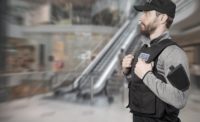Every generation is marked by the safety measures it experienced during its formative years. For those whose school days spanned the 1960s – the height of the Cold War – it was the infamous “Duck and Cover” drills. For the next generation, “Stop, Drop and Roll” exercises became the safety mantra of the day. If we want today’s children to look back on their school days as more than just a time of “Run, Hide, Fight” training, lockdowns and lectures on the potential dangers of online behavior, school systems need to institute security measure that will create safer learning environments without making schools feel like prisons.
Meeting the Four Basic Tenets of Physical Security
There are no absolutes for achieving that delicate balance between strong physical security and carefree learning. But any measures a school considers should incorporate the four basic tenets of physical security: deterrence, detection, delay and response.
- Deterrence: measures to prevent malicious activity from happening
- Detection: measures to alert school authorities that malicious activities are happening
- Delay: measures that slow down the perpetrators who are committing the activity
- Response: measures that alert perpetrators that they have been detected and will face consequences
Keep in mind that these four tenets should apply not only to technology, but to people and processes as well.
Taking a Layered Approach to Security
In the absence of national standards for schools to reference, current approaches to physical security have tended to differ widely from one institution to the next. But one of the most effective approaches schools might consider is one that is built in layers – working from the inside outward.
This concept isn’t unique. Security practitioners have commonly used this defense-in-depth, layered approach when designing security systems for other organizations. In this model, resource deployment is driven by the criticality of the assets needing protection. In the case of schools, life safety would be the most important factor for determining where to invest security resources.
First Priority (Layer One): The Classroom
Students spend the vast amount of their school day in classrooms, so schools should prioritize those areas first.
- DOOR LOCKS:
The number one recommendation from the Sandy Hook Advisory Commission was to ensure that classroom doors could be locked from the inside by teachers or substitutes. Upgrading door hardware is often considered too expensive. As a consequence, some schools have been resorting to aftermarket, less expensive “barricade” devices that often introduce other life safety issues by compromising fire codes and ADA requirements.
When budget is not as much of an issue, Electronic Access Control should be considered as it enables centralized lockdown capabilities reducing human error and dangerously slow reaction time. Regardless of the method, preventing intruders from entering the classroom addresses two important tenets of physical security: deterrence and delay.
- BI-DIRECTIONAL INTERCOMS OR PHONES:
Another key technology requirement for classrooms is the ability to communicate with the others in the school building or outside entities. Today, classrooms should be equipped with bi-directional intercoms or phones that provide “push to talk” functionality. You don’t want teachers to have to memorize extensions to call the front office. Modern intercoms are connected to the schools IP network and support the same protocols for communication as the phone system. These Powered-over-Ethernet (PoE) devices can be used not only to connect with the front office but could even allow external entities with the right credentials, such as law enforcement, to connect to the classroom.
With regards to people and process, teachers and substitutes should be trained then tested on these systems regularly. One idea to ensure continued proficiency with the technology is to have teachers use the intercom in their daily routines such as reporting in at the beginning of each day.
Second Priority (Layer Two): Building Perimeter
Moving outward from the classroom our next priority is the building perimeter or “envelope.” We want to control who can enter the facility and limit their movement based on who they are. This can be accomplished through a combination of technology, people and processes.
- ONE MAIN ENTRANCE:
A best practice is to have all students and visitors enter through one set of doors which is clearly marked as the main entrance. These doors would be unlocked during a specified time in the morning and afternoon for easy entry and egress but would be physically monitored by staff such as a school resource officer who would greet people as they enter. The doors would be locked for the rest of the school day.
- VIDEO INTERCOM AND VISITOR MANAGEMENT SYSTEM:
These doors would have a networked intercom system that includes video so that visitors can be screened before the doors are unlocked. In some cases, schools could require visitors to hold up a driver’s license or other photo ID before unlocking the doors. Once inside, the visitor should be required to show a picture ID that would be entered into an electronic visitor management system that produces a credential that indicates this person is a visitor. By requiring visitors to sign in, schools create a deterrent as well as control who can enter the facility.
Third Priority (Layer Three): Outdoor Space
Not all schools are contained within four walls. Many K-12 institutions in America are made up of multiple buildings, and almost all of them have outdoor spaces that students utilize throughout the day. Often these outdoor areas are considered public property and are used by private citizens when school is not in session. Schools commonly define their grounds by installing fencing around school property. But fencing does not always provide the deterrence value school security professionals hope for, especially if the public is permitted to use the space after hours. This dilemma has led schools to look for detection methods that can provide early warning of an intruder entering school grounds during school hours and prevent after hours issues such as vandalism or theft.
- VIDEO SURVEILLANCE WITH ANALYTICS:
Many schools leverage video surveillance with motion detection analytics to proactively notify security when anyone enters restricted areas around school property. For instance, kids playing on the school’s basketball court over the weekend won’t trigger an alert. But if they approach the school building itself, an alert will be sent to authorities (whether school security staff or local law enforcement).
School Security Shouldn’t Feel Like Prison
Schools are faced with security challenges on multiple fronts. Some of those challenges can be addressed through technology. But people and processes following the basic tenets of physical security are also important to ensure that safe schools don’t feel like prisons.



